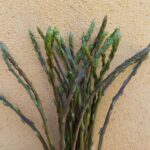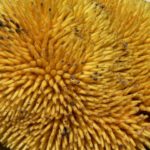Nara melons were in former times the only food Topnaar people had available for 4 months (Jan – April) a year. The rest of the year they used conserved fruit pulp and seeds for supplementing other food sources. They were able to buy additional food sources from income generated by selling Nara seeds. So, all-in-all, the life of the Topnaar people depended and still depended on Nara fruits, small livestock, and supplement income. As an interesting matter of fact, it was archeologically proven, that the original inhabitants of the land already ate Nara seeds at least 8000 years ago.

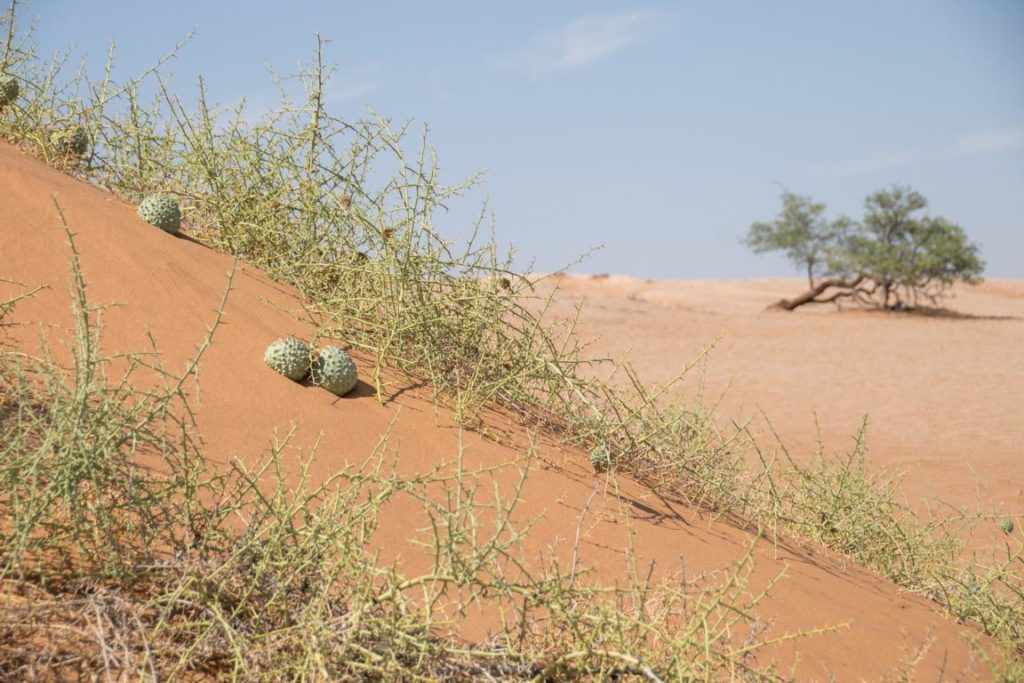
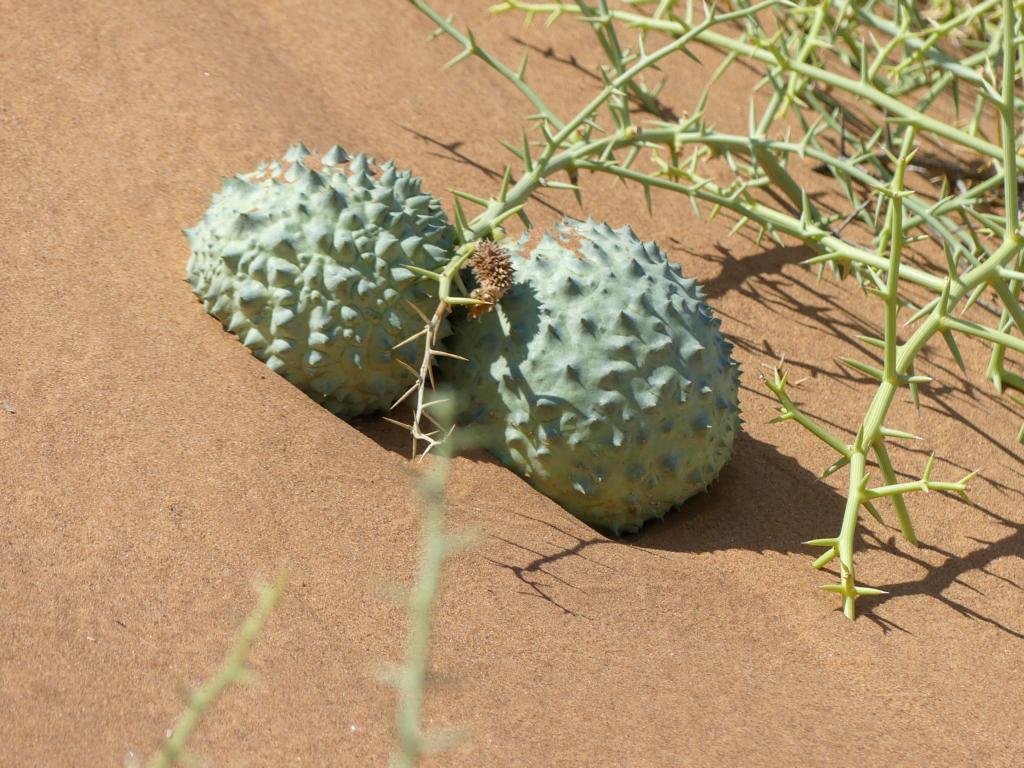
Synonymous names
- Scientific name: Acanthosicyos horridus
- Khoekhoegowab/Damara: !Nara (! = click sound)
- Afrikaans: Botterpitte
- English: Nara, Butter pits
Description of Nara plants
Nara plants belong to the cucumber plant family. They form bushes without leaves to reduce transpiration. They photosynthesize by their longitudinal grooved twigs and spines. These – very sharp – spines are about 1’’/2,5 cm long and paired symmetrically.
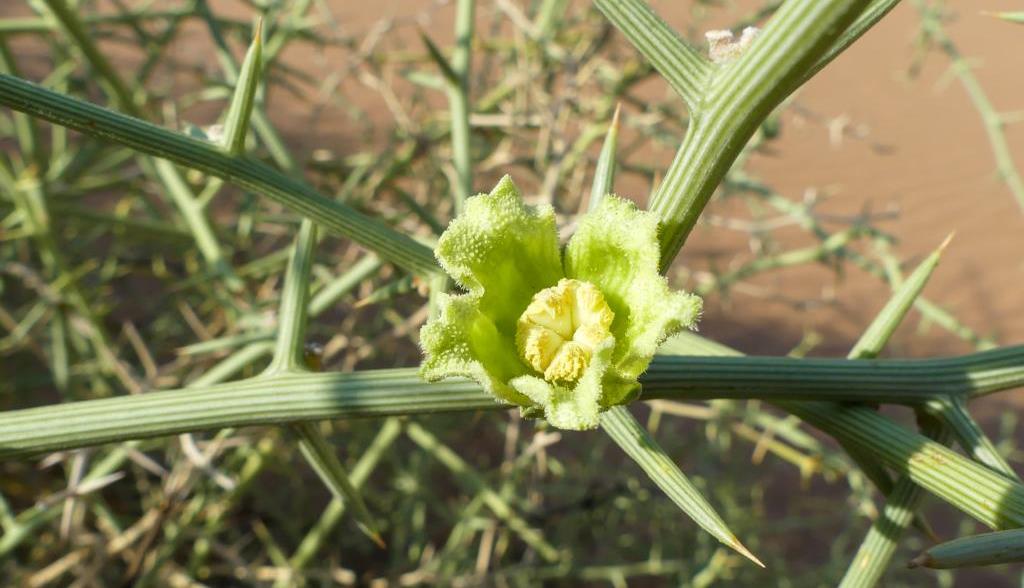
Naras are dioecious plants, with male- and female flowers on separate plants. The roots are massive and reach up to a depth of 40 m to the groundwater level. Fruits look like melons with thorny protuberances and length sizes of between 15 – 30 cm (abt. 6’’ – 12’’). The pulp of ripe fruits is yellowish and contains about 200 – 250 seeds. Generally, Nara plants are important for the whole desert ecosystem. They not only provide food but also offer protection for animals and stabilize dunes.
Distribution
These plants are endemic to coastal areas in Namibia and Angola. They also grow at the end of dry river beds and the bases of dunes. Important for their distribution is, that their roots can tap into groundwater. An information sign at ‘Gobabeb Namib Research Institute shows the distribution of Nara plants according to the attached picture. The densest distribution of Nara fields is at the Kuiseb delta and along the Kuiseb River, which is also the main settlement area of the Topnaar people. It also has to be mentioned, that Nara melons are and were always available for OvaHimba people in the North-Western corner of Namibia and Southern Angola. OvaHimba however is keen on eating these melons and regards them just as emergency- / famine food.
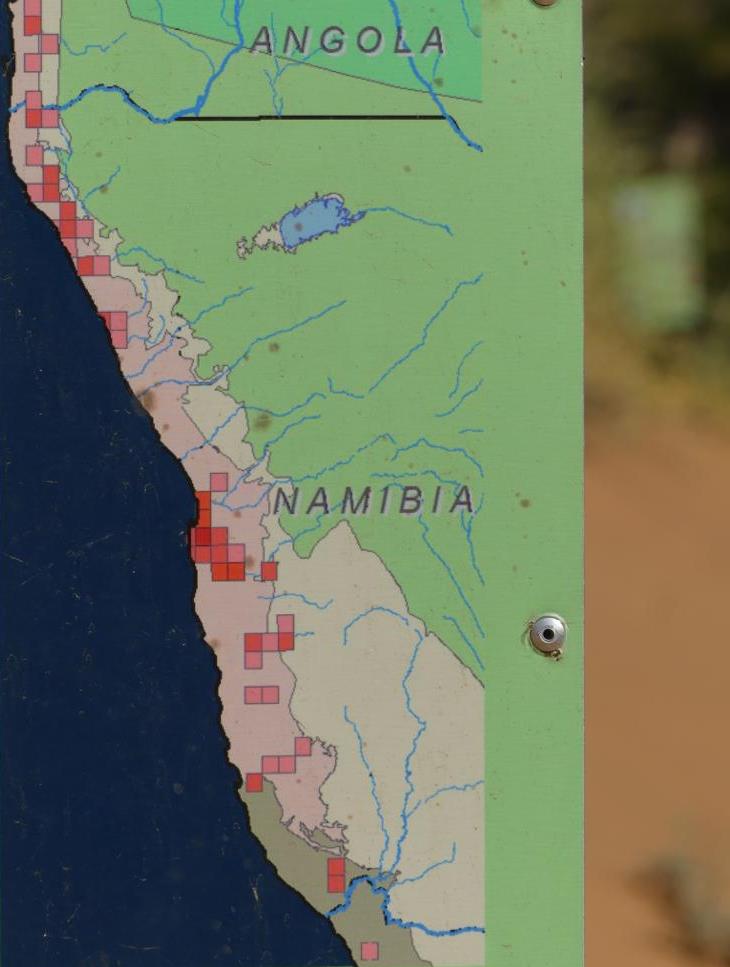
Ownership of Nara plants
The Nara fields were divided into patches and allocated to different families, passing on to successive generations through inheritance. This ensured the sustainability of resource use. As Nara plants were of foremost importance for Topnaar families, the Nara growing areas were fiercely defended by them against Damara and Khoi-san intruders. Still, at the beginning of the 20th century, these intruders were shot on site and with no repercussions from the judiciary, which was in this case the chief of the Topnaar tribe. Nowadays, however, the Nara fields are commercialized and have become a communal resource with no private ownership anymore. It has to be seen how well this system will protect the species in the future.
Harvesting of Nara melons
Harvesting of Nara fruits is done 4 months long from January to April every year. On average it requires 3 hours of harvesting for one kilogram of seeds. Both ripe and unripe melons will be loosened from the bushes by long wooden sticks and hooked iron rods. Ripe fruits are yellow outside. Unripe fruits are still green and will also be collected. Such unripe fruits will be covered three days long by sand and plastic tarps for ripening. The harvested melons will be returned to the living quarters by donkey carts for further processing.
Processing of Nara melons
In former times, the Nara shell was opened with a bone knife carved from beef rips. With the help of these thin and flexible bone knives, also the whole inner fruit flesh was scooped out of the shell.
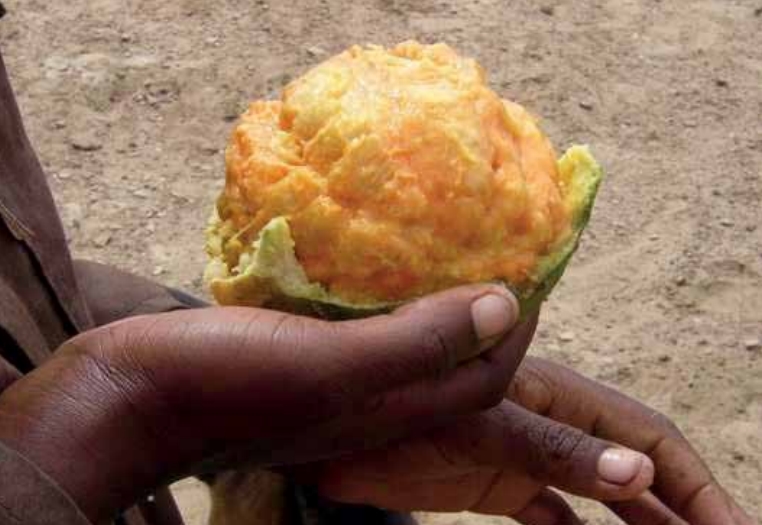
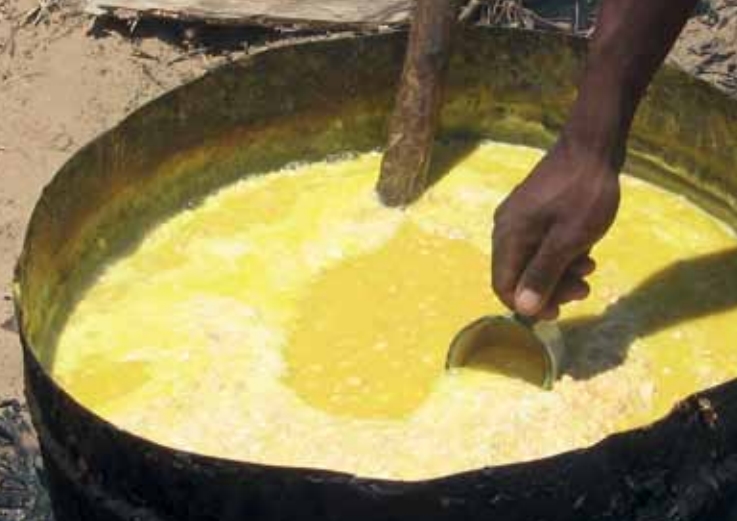
Both photos were copied from: Indigenous Natural Plant Products in Namibia, published by Venture Publications Windhoek Namibia, 2014, Chapter 1; Copyright by Gillian Maggs-Kölling, Rosalia Iileka, Ruusa Gottlieb, and Esther Uushona. This book can be downloaded here.
The ripe fruit flesh can either be eaten raw, or it will be boiled to a pulp. For pulping, the whole inner fruit (flesh and seeds) will be put into a large drum and cooked on an open fire. The pulp will be reduced to about half of its original volume under constant stirring. During cooking, floating seeds (these are empty ones) and scum will be scooped off. When finally reduced to the required thickness, the pulp will be scooped out and strained from the remaining seed. For straining, typically old cans with holes in the bottom will be used.
Uses of Nara melon products
The remaining pulp without seeds was traditionally dried directly on hot desert sand for about three days. This resulted in ‘Nara leather’, which was about 1 – 3 mm thick, looked like leather, and could be stored indefinitely. Nowadays, the pulp is poured onto plastic sheets, dried also about three days, and sold as ‘Nara chocolate’. Fruit leather, either with or without sand, can be eaten as a snack or together with porridge.

Seeds are also dried and eaten by cracking open like sunflower seeds. In the past, they were also crushed and added to porridge again. These seeds should have a yellowish color outside, which proves that they were not washed with water, but came directly from pulp cooking. It is said that unwashed seeds got a better taste due to micro-fermentation processes. The English name ‘Butter pits’ is very appropriate, as they contain 57% of fat and 31% of proteins.
Also, peels of Nara fruits were and are not going to waste. These peels are a sought-after feed for goats and donkeys. And the unwanted seed is picked up by chickens.
Lessons learned about Nara melons:
- Nara melons were the main staple food for Topnaar people in the Kuiseb Delta of Namibia.
- The Nara fields were divided into patches and belonged to certain families, which defended them vigorously.
- Harvesting time of Nara melons spans over four months and unripe fruits can be ripened easily.
- Ripe Nara melons are either eaten raw or will be boiled up to a pulp.
- Pulped fruit flesh will be poured onto sand or sheets and dried, which results in fruit leather.
- Strained-off seeds will also be dried and thereafter either eaten raw or ground into porridge.
- Nara seeds contain 57% fat and 31% protein.


